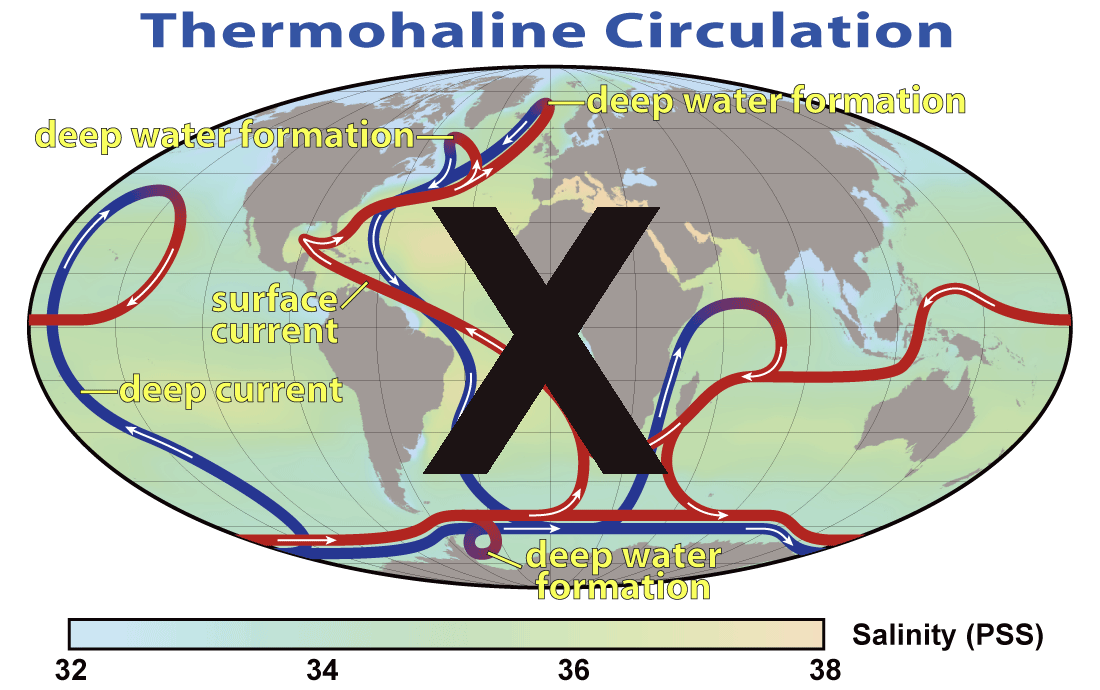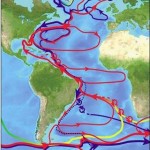Science Daily is reporting that just because they teach you something in graduate school doesn’t make it right. A 50 year old model of global thermohaline circulation that predicts a deep Atlantic counter current below the Gulf Stream is now formally called into question by an armada of subsurface RAFOS floats drifting 700 – 1500m deep. Nearly 80% of the RAFOS floats escaped the Deep Western Boundary Current (DWBC), drifting into the open ocean.
This confirms suspicions that have been around since the 1990’s, and likely plays havoc with global models of climate change. The findings by Drs. Amy Bower of Wood’s Hole and Susan Lozier of Duke University et al. are published in a forthcoming issue of Nature.
The implications would be for more cold, oxygenated water along the Mid-Atlantic Ridge, but I’m just making that last part up. Best to read for yourself. As I recall, the DWBC was notoriously slow. You have to wonder whether a big yellow glass float responds to these currents the same as suspended matter, like plankton and particulates. Either way, the research represents a major paradigm shift in ocean circulation theory.
Citation:
Bower, A., Lozier, M., Gary, S., & Böning, C. (2009). Interior pathways of the North Atlantic meridional overturning circulation Nature, 459 (7244), 243-247 DOI: 10.1038/nature07979
Image above from Wikimedia Commons.







OMGWTFBBQ! Everything I know about oceanography is wrong!
(no, really, that’s about 90%)
(ok, not really)
Interesting piece – but it seems that circulation is still alive and well, just not via the DWBC. Instead its potentially slower, more variable, and more wander-y in the interior ocean. Interesting. And the implications are eyebrow-raising.
And who knows what’s going on in the Pacific!
I no longer believe in physical oceanography.
@jebrynes:
I love seeing other types of geek get excited :D
“Instead its potentially slower, more variable, and more wander-y in the interior ocean.”
I am a researcher, and, frankly, I am not the least bit surprised by your statement. I’d argue the authors’ result is essentially a no-brainer insofar as the ocean, like the atmosphere, operates by fluid dynamics. In the atmosphere, there isn’t just the jet stream but also fronts, pressure centers (or eddies, essentially), and even small scale circulations such as tornadoes.
Slashdot.org carries this story today with heaps of denial in the comment section. People seem to think these results dispel global warming.
No, not that they deny global warming, but rather invalidate the global circulation models that currently assume the DWCB. Fitting those models to the past ~100 years, and then projecting them ~100 years into the future results in apparent global warming. Now, the results of those models will change, in one direction or another.
But that’s what happen when you base a political movement on computer model projections…
In reply to Peter,
These results dispel the claim by Global Warming Alarmists that the science of GW is settled.
Peter,
Some on /. may say it dispels global warming. The ones that aren’t being sarcastic or openly ignorant are saying that any large-scale chaotic system is difficult to monitor and understand. Global climate change is based on an understanding of many, many large-scale chaotic systems. Slight modifications or margins of error can drastically change the predicted results.
With all of the “adjustments”, “findings”, and “unknown” factors that make up global climate change arguments, is it wise to spend trillions of dollars and make hasty decisions?
We could all very likely be arguing about whether the Earth is flat (at least, that is how ignorant all of this may sound in the future). I’m sure they thought they knew it all back then, too.
Global warming is already proven to be a fraud.
The fact that the earth has been cooling for the past 10 years would seem to be indication enough to dispel global warming. You need to update your catch phrases. It’s now called “climate change”. If it’s sunny outside, it’s climate change. If it’s raining outside it’s climate change. If it snows it’s climate change. See? By using the phrase “climate change” you don’t need any science or theories to explain it. If a tree falls in the woods it’s climate change. As long as humans live somewhere on the earth any time the climate changes it’s our fault. Millions of years ago when the earth got warmer and colder it wasn’t our fault because we weren’t there to see it, but if we were it would have been our fault too.
I ask this out of total ignorance, but is there any chance the study was done recently, and is showing the shutdown of the conveyor current? In other words, the current was stronger earlier and working as previously modeled, and this is indicative of a radical change?
It doesn’t dispel AGW, it just call more question the the “science” that’s been rammed down everyone’s throats for the last decade or so.
No Peter, they think the results show that the GCM’s must be wrong (of course they must) and the GCM’s are the foundation stone of the AGW movement.
um, that is just slashdot’s normal snarkiness. your best bet is to never, evar read the comments over there. :)
Nobody sane wants to speak for slashdot. That being said, how many models have been used by the IPCC? How many models would be invalidated by this finding? How much of global warming consensus is left after you take the models away?
I like science, scientism, not so much.
The point of the story is to say that things that we thought were concrete facts are simply more variable than we thought.
The world is quite a dynamic place.
This should make us rethink everything that was based on the previous “fact.”
Peter: Provided that this “global warming” thingy exists, of course. Or, should I rather say, the “OMG most of of the climate change is anthropogenic we are killing the planet” part, which is the part that everyone cares about whenever the global climate change is discussed. Because as far I can tell, there are few deniers of the fact that climate is changing on Slashdot, but there are far too many people unwilling to be fooled by snake oil salesmen from IPCC. I doubt that anyone on Slashdot will ever question the work of honest scientists.
To get published in Nature(Green Peace East), It will have to point to an enhanced AGW effect. Do not expect a non biased piece in Nature. I have dropped my membership.
I’d say a more accurate response is “just because a scientist says something IS, doesn’t mean it IS.” Most people would appreciate an honest statement that says “Given our current information, we believe this to be accurate.” when most of what we hear is “It’s this way, end of discussion.”.
I’ll confess to being one of those Slashdot geeks, but something about this makes me wonder if 700-1500 metres sounds a bit shallow, somehow.
I mean, if there is a massive river of cold water moving down there, it’ll be right down at the bottom, wouldn’t it? Being the coldest water, it’ll sink right down to the bottom of the water column and flow more or less across the ocean floor, doing what water does (running downhill) through the lowest part of the ocean.
So, if the abyssal plains are at 4,000 to 6,000 metres, and the trenches are even deeper than that, it occurs to me that there’s plenty of room for a five or ten mile wide, 20 metre “deep”, say, river to be pouring away south down there and for these buoys to miss it completely.
@Peter: Not necessarily, but it raises questions that can’t simply be dismissed easily or flippantly. Case of pot calling the kettle black ? People seem to think that to even think of questioning “climate change” is some sacred cow that can’t be poked and prodded. The idea in all science IS to question. Nothing precludes doing what one can to push for reduced emissions, replanting forests, just the same.
I can off the cuff hypothesize reasons why empirical data may not match theory in this case such as simple Brownian motion or periodic local events like Atlantic ridge eruptions creating a temperature gradient. These could explain why empirical measurements would make the the model difficult to calibrate.
Look. We know the earth is heating up on a geometric path. Do you really want to just ignore it? We are smart enough to realize that h
humans have an impact on the environment. The temperature elevator is a good theory.
Just because we can measure it yet doesn’t mean the world is flat. Look how long it took us to empirically measure dark matter from a solid theory. There are plenty of acute reasons to reduce smog. Do your share.
“You have to wonder whether a big yellow float responds to these currents the same as suspended matter, like plankton and particulates.”
RAFOS floats are not big and yellow, they are made of glass and are about 2m long and 170mm diameter.
Thanks RNelson. I was mixing them up with another float, still calling 2m “big” in relation to plankton. That’s fixed above.
You are welcome and thanks for making the correction.
What I’m taking from this is that people are angry about alarmism, angry that global warming is being “rammed down their throats”, and angry that they may be taxed. This is not necessarily to say they disbelieve that the climate is warming, just that opinion is split on whether the causes are natural or human-induced.
Let me be clear about my position. I sympathize with this confusion, because I am familiar with circulation models, and I know its an inexact science. I am also familiar with environmental NGOs, and I know some are prone to fear mongering to stimulate new resources. I’ve been taught that there is a causal connection between humans and elevated CO2, and that where comparable levels of CO2 occurred in the past, drastic changes have occurred.
Still, I try to be balanced and optimistic. We fixed the problem ozone layer, apparently. We can do better than fossil fuels. The CO2 problem does exist, and it can be addressed. How it manifests itself is open to debate, as we have happening here. However, just because a circulation model is inexact does not mean human induced climate change is not a problem.
True Peter, but then you say “we fixed the hole in the ozone layer”, which isn’t strictly true. What we did was fix a problem that didn’t exist, in that the hole in the ozone layer comes from natural variation (indeed, some connection with high energy particles has recently been described). Of course, nobody talks about the ozone layer any more; did you hear a retraction in the media? I didn’t.
I don’t agree that CO2 is a problem. As I’ve said before, CO2 is close to a record low with respect to Earth’s climate. It isn’t true to say that comparable levels of CO2 occured in the past causing drastic changes. Where on earth did you get that information from? It can be demonstrated that CO2 responds to temperature, not the other way around (the forcing from CO2 is tiny!). CO2 has been thousands of PPM in the past; higher temperature is always associated with a thriving biosphere. The same cannot be said of the cold.
AGW is based on and constructed with the output of GCM’s. That the GCM’s are blatantly wrong should be cause for concern. Less credulous and stupified minds have long understood this.
I’m going to check my references and get back to you, Robinson. I am obviously not an expert in climate change, I use circulation models to help predict currents, downwelling, stratification and other parameters that may infuence the distribution of my study animals- deep corals.
Its important to note, though, that just because drifters escape the DWBC doesn’t mean the current doesn’t exist, as I mentioned, it was always considered a slow flow. The models clearly need to be adjusted, though.